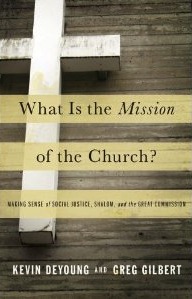 In this post, I want to commend Kevin DeYoung and Greg Gilbert’s two chapters on Social Justice: “Making Sense of Social Justice: Exposition” (6) and “Making Sense of Social Justice: Application” (7) in their book What’s the Mission of the Church?.
In this post, I want to commend Kevin DeYoung and Greg Gilbert’s two chapters on Social Justice: “Making Sense of Social Justice: Exposition” (6) and “Making Sense of Social Justice: Application” (7) in their book What’s the Mission of the Church?.
These chapters usefully center of a pendulum that has swung far in one direction for some time. This will perhaps alienate me from some readers, but I have to agree with DeYoung and Gilbert that the Bible’s message is not primarily about social justice. As I have said in an earlier post, I believe the story line is about God’s vindication (by the way this word is related to the nouns righteousness and justice), which is connected to the issue of social injustice for sure, but it is not the primary concern of Scripture.
This does not take away the fact that the Bible says a very great deal about the poor. I’ve heard Jim Wallis powerfully talk about a Bible with holes. The image of a Bible with all the poverty passages cut out of it. My experience growing up in fundamentalist and evangelical circles is Wallis’ “Bible with holes” was, for all intents and purposes, our Bible.
No fraud, no favoritism
In the first of the two chapters DeYoung and Gilbert explain the meaning of 12 common “social justice” texts: Lev 19:9-18; 25; Isa 1; 58; Jer 22; Amos 5; Micah 6:8; Matt 25:31-46; Luke 10:25-37; Luke 16:19-31; 2 Cor 8-9; and James 1; 2 and 5. While one could quibble with certain omissions like Luke 4 (although they discussed it earlier in the book [37-39] and unfortunately dismissed its relevance for defining mission), it is a solid contribution of commonsense exposition of key texts. In finishing with James they write:
The Bible condemns in the strongest of terms fraud and favoritism. More than that, we are positively enjoined to show special compassion to the most helpless among us. If we truly believe the gospel of God’s grace, we will be transformed to show grace to others in their time of need. You may want to reread the previous three sentences, for they provide a good summary of the Bible’s teaching on social justice: no fraud, no favoritism, help the weak, freely give as we have abundantly received (171).
Unconstrained and Constrained Justice
DeYoung and Gilbert observe that the term “social justice” often goes undefined and they believe this is a problem since anything can parade around as social justice. And since that label has a significant cashe these days, it allows for an activity to go if can slap that term on it. As they put it “who in their right mind favors social injustice” (180). They suggest that there are two ways to define the term. The unconstrained approach thinks that justice is a result so that whenever people don’t get their “fair share” there is injustice (181). Inequality of resources whether they be opportunities, income, or education, in this view, is injustice. The constrained view sees justice as a “process in which people are treated fairly” (181). Justice on this view is upheld by “the rule of law, a fair court system and equitable treatment of all persons regardless of natural diversity” (182). DeYoung and Gilbert believe that the constrained view is more closely reflects the way the Bible speaks of justice. Still they acknowledge that both views can be understood as biblical (citing Tim Keller). Their interest is primarily that “we don’t all mean the same thing by ‘social justice’ and therefore we should be careful to define what we mean if we use the it” (183).
I think their point needs to be heeded. For me, I believe social justice includes both on the simple fact that justice in the rule of law is dependent on the assumptions and applications of that law. There is such a thing as systemic injustice. It does someone no good if she is being justly treated by a rule of law that is unjust. Social justice must also relate to the systemic injustice of society.
Moral Proximity
The last item I think is noteworthy out of these chapters is DeYoung and Gilbert’s discussion of the concept of moral proximity. I found this section useful. Moral proximity is the simple idea that those whom we are most closely connected to are our first and most important moral responsibility. This does not primarily mean geographical proximity, but it certainly includes that. And given our “global village”, moral proximity can then also be global. Here the helpful thing is to work with a moral vision that allows one to make decisions about what to prioritize with the limited resources at our disposal. This section provides a good resource. I laughed out loud at one point when I read this very true excerpt:
Without the concept of moral proximity we end up just putting “helping the poor” in the disobedience column and start thinking about football (185).











